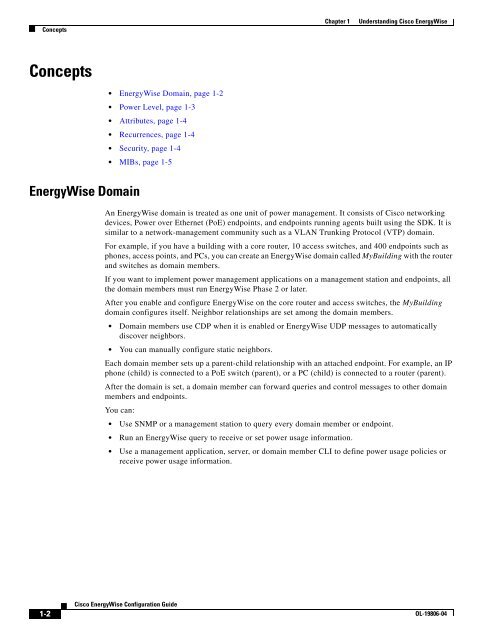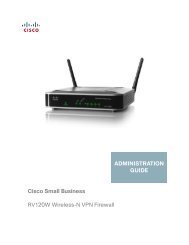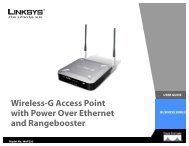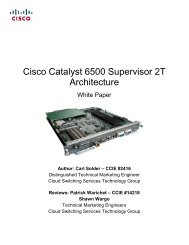Cisco EnergyWise IOS Configuration Guide - Ipland
Cisco EnergyWise IOS Configuration Guide - Ipland
Cisco EnergyWise IOS Configuration Guide - Ipland
Create successful ePaper yourself
Turn your PDF publications into a flip-book with our unique Google optimized e-Paper software.
Concepts<br />
Chapter 1<br />
Understanding <strong>Cisco</strong> <strong>EnergyWise</strong><br />
Concepts<br />
• <strong>EnergyWise</strong> Domain, page 1-2<br />
• Power Level, page 1-3<br />
• Attributes, page 1-4<br />
• Recurrences, page 1-4<br />
• Security, page 1-4<br />
• MIBs, page 1-5<br />
<strong>EnergyWise</strong> Domain<br />
An <strong>EnergyWise</strong> domain is treated as one unit of power management. It consists of <strong>Cisco</strong> networking<br />
devices, Power over Ethernet (PoE) endpoints, and endpoints running agents built using the SDK. It is<br />
similar to a network-management community such as a VLAN Trunking Protocol (VTP) domain.<br />
For example, if you have a building with a core router, 10 access switches, and 400 endpoints such as<br />
phones, access points, and PCs, you can create an <strong>EnergyWise</strong> domain called MyBuilding with the router<br />
and switches as domain members.<br />
If you want to implement power management applications on a management station and endpoints, all<br />
the domain members must run <strong>EnergyWise</strong> Phase 2 or later.<br />
After you enable and configure <strong>EnergyWise</strong> on the core router and access switches, the MyBuilding<br />
domain configures itself. Neighbor relationships are set among the domain members.<br />
• Domain members use CDP when it is enabled or <strong>EnergyWise</strong> UDP messages to automatically<br />
discover neighbors.<br />
• You can manually configure static neighbors.<br />
Each domain member sets up a parent-child relationship with an attached endpoint. For example, an IP<br />
phone (child) is connected to a PoE switch (parent), or a PC (child) is connected to a router (parent).<br />
After the domain is set, a domain member can forward queries and control messages to other domain<br />
members and endpoints.<br />
You can:<br />
• Use SNMP or a management station to query every domain member or endpoint.<br />
• Run an <strong>EnergyWise</strong> query to receive or set power usage information.<br />
• Use a management application, server, or domain member CLI to define power usage policies or<br />
receive power usage information.<br />
1-2<br />
<strong>Cisco</strong> <strong>EnergyWise</strong> <strong>Configuration</strong> <strong>Guide</strong><br />
OL-19806-04

















